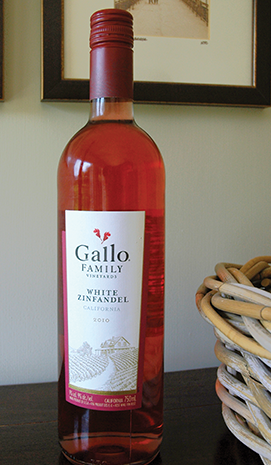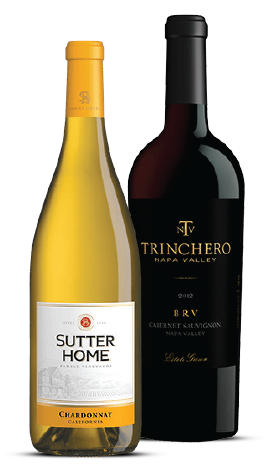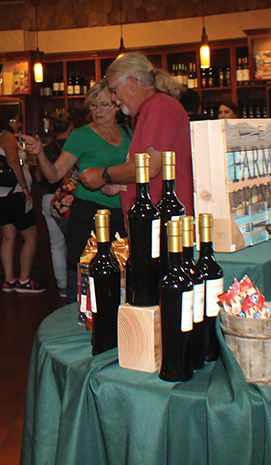Immaculately manicured rows of grapevines … large holding tanks rising toward the sky … rooms stacked with barrels, aging a fine vintage.
All are familiar sights in the Central Valley.
Known for many things, from being the Gateway to Yosemite to boasting some of the most productive agricultural land in the state, the Central Valley — which includes much of the 209 — is also home to some of the largest wineries in the world. And those local wineries are a force to be reckoned with on both a national and international level. The value the industry brings to the region can’t be underestimated, from those working in the fields to pick the grapes, to the truck drivers bringing in trailer loads during the crush, to the winemakers who tinker with the formulas to get just the right taste to please the palate, the wine industry is both a major employer and provides a huge economic boost.
August to October are key months for the ‘crush’ – when the trucks are coming in and the wineries virtually run around the clock.
Among the largest wineries in the region are The Wine Group, Gallo, TFE (Trinchero Family Estates), Bronco and Delicato.
The Wine Group
For CEO Brian Vos at The Wine Group, that’s when things get interesting.
“We have seen an explosion in the number of California wineries,” Vos said, adding that “growth in importance of brand building” as well as globalization of California wines has had the most impact on The Wine Group in the past 10 to 20 years.
Headquartered in Ripon, that is just a small part of The Wine Group’s footprint.
“We have 11 wineries in California, one in New York and one in Australia,” Vos said. “Our administration is in Tracy, sales/marketing in Livermore at Concannon Winery.”
The Wine Group can trace its roots all the way back to 1933, when Teresa Franzia borrowed money at the repeal of Prohibition and split the 10k she borrowed between her sons –who went on to form Franzia Winery in Ripon – and her new son-in-law, Ernest Gallo. He and his brother then founded what became Gallo Winery in Modesto.
“Amazing story about how a female immigrant from Italy basically funded three of the world’s biggest wine businesses; Gallo, The Wine Group and Bronco all have their roots in Franzia,” said Vos.
The Wine Group has brands that are familiar and accessible.
“TWG’s brands can be found nationally almost everywhere you find wine. We are the second largest wine producer in the U.S. (behind Gallo). We are focused on building strong national brands,” Vos explained.
Among those brands are Franzia, Cupcake Vineyards, Corbett Canyon, Almaden and Oakleaf.
The business has grown and expanded over the years, with a few key dates including: 1983 when they introduced Franzia Winetap (bag in box) to market; it has since become the world’s largest volume wine brand.
In 1984, they introduced 20/20 Orange Wine Cooler; in 1988 acquired Corbett Canyon winery; in 2007 launched Cupcake Vineyards; and in 2015 acquired Benziger Family and Imagery wineries in Sonoma.
“We are a very diversified wine company, offering wines and brands sourced from many of the diverse California growing regions, and ranging in price from $3 to $80 per bottle. In addition to producing wines from grapes grown in the Central Valley, we produce wines from Sonoma, the North Coast, Monterey, Paso Robles, the Central Coast and Livermore Valley just to name a few,” Vos said of the every-growing footprint. “We also import signature wines like Prosecco, Pinot Grigio and Moscato di’Asti from Italy, Malbec from Argentina and Sauvignon Blanc from New Zealand.”
As more people begin to enjoy wine, which has many health benefits along with pairing with nearly any type of cuisine, Vos said The Wine Group wants to make sure the consumers get what they want.
“Given our roots in the Central Valley, we remain passionate about and committed to producing high quality wines from this area. The growing recognition of the quality of California appellated wines has made the development of brands that sell for $10-plus per bottle a big opportunity for wineries and growers in our area,” he said. “The absolute quality and the year to year consistency that we can deliver from the Central Valley is driving the growth of California wines, and given the limited room for growth in places like Napa and Sonoma, we are very optimistic about the future of wines developed in our area.”
E. & J. Gallo Winery
Gallo has been a name synonymous with wine for decades and President/Chief Executive Officer Joseph E. Gallo of E. & J. Gallo Winery said he is proud of the family tradition.
“The E. & J. Gallo Winery was founded in 1933 by my father, Ernest, and my uncle, Julio Gallo. The two brothers started the winery in a small building at 11th and D Street in downtown Modesto that they rented from the Beard family. The building still stands today. When they began, the odds of success were very formidable. The country was in the midst of the Great Depression and they were facing larger, more established competitors,” Gallo explained. “Their first goal was simple – survival. They were merely trying to build a business that could provide for their families.
As they began to succeed, their goal evolved into a vision – to transform a beer- and whiskey-drinking nation into a wine drinking culture. Through their hard work, trust in one another and vision, their small company grew beyond their wildest dreams. It is a true ‘only in America’ success story.”
Today, it is the largest family owned winery in the world and 15 family members, spanning three generations, continue to actively work in the business. The company is based in Modesto and has more than 6,500 employees across the country and throughout the world, Gallo said.
With the industry being key to the region’s economic health, Gallo said there is plenty of reasons for cooperation among the wineries.
“We have great respect for the wine industry, particularly local wineries and winegrape growers. We have long been involved in various industry groups to collectively promote the wine industry, which has proven to be instrumental in the growth and popularity of wine today,” he explained. “The Central Valley is a long way from reaching its peak when it comes to wine production. The region is growing better grapes than ever before which is resulting in better wine.”
It’s hard to think of Gallo without also thinking of the words “award-winning wines” and the CEO points to some major successes along the way.
“The Gallo portfolio is comprised of more than 80 unique brands and many award winners including Barefoot Cellars, Dark Horse and Gallo Family Vineyards, as well as premium box wines The Naked Grape and Vin Vault,” Gallo said. “Gallo Spirits offers New Amsterdam Vodka and Gin and E&J; Brandy, in addition to imported Scotch whiskies from Whyte & Mackay, including The Dalmore, Jura Single Malt and John Barr Blended.”
From its humble beginnings as a small family operation to the huge business it is today, Gallo said they have grown with the market.
“One of the major changes that has occurred in recent years is that consumers are making wine a part of their daily life. Today, wine has enormous exposure among consumers, unlike previous generations where wine was often only available for special occasions,” noted Gallo. “Wine is a daily staple on television cooking shows, in wine and food magazines and lifestyle blogs. People are enjoying exploring and discovering new and different wines. Another positive change is as they choose wine as their beverage of choice, they are finding great tasting wines at a variety of price points to meet and satisfy their needs. All of this has been good for the California wine industry.”
Trinchero Family Estates
Bob Torkelson serves as President and CEO of Trinchero Family Estates, also known as TFE. Like his counterparts in the Central Valley, he has seen TFE grow from a family-owned business to a world player.
“Mario Trinchero was an Italian immigrant who came to Napa Valley from New York City with his young family in the late 1940s. Mario and his brother purchased an abandoned, Prohibition-era winery and opened the doors of Sutter Home Winery in 1948,” Torkelson explained of the business. “The Trincheros initially scraped by as a mom-and-pop operation, until Mario’s son Bob created the world’s first-ever White Zinfandel in 1972. Today, Trinchero Family Estates is the second-largest family-owned winery in the U.S., with over 45 acclaimed wine and spirits brands and a global presence in more than 50 countries. TFE employs more than 1,000 talented winemakers, viticulturists, marketers, sales professionals, distributors and supply staff.”
Torkelson also sees cooperation as being key to continuing to grow the industry here.
“We partner closely with Napa Valley Vintners and other organizations who work tirelessly to promote the wines and destinations of Napa Valley. Given our 70-year heritage in the region, we bring a unique historical perspective to the wine culture of Napa Valley. We are deeply invested in the region, and we are proud to help shine a light on the world-class wineries here,” he said. “My role is to guide the organization toward the Trinchero family’s vision for the future. Together with a phenomenal team, I work to honor the family’s almost 70-year legacy in Napa Valley and support the winery’s growth, through new product innovation, strong partnerships and an unwavering commitment to quality.”
TFE has over 10,000 acres of vineyards throughout the state and grow grapes including Chardonnay, Cabernet Sauvignon, Merlot and Pinot Noir. As he looks to the start of the crush, Torkelson said that’s when the business is at its best.
“Everything we do throughout the year to nurture the vines culminates at harvest time. There is a palpable excitement in the air during crush season. For our viticulturists and winemakers, this is the moment when all their hard work and dedication pays off, when that meticulous care in the vineyard comes to life in the cellar,” Torkelson explained. “Crush varies across grape varieties and regions, but we typically begin picking our fruit in late August or early September, and harvest wraps up by late October or early November.”
Familiar names out of the TFE include Sutter Home, as well as Menage à Trois, Folie à Deux, Napa Cellars, Joel Gott Wines, Charles & Charles, Taken and Bandit.
“Our growing collection of luxury brands include Trinchero Napa Valley – the pinnacle of our portfolio – and partnerships with boutique producers Ziata, Bravium, Mason Cellars and Neyers Vineyards,” added Torkelson.
For those that like to head out on a tasting tour, Trinchero Napa Valley has a brand new, state-of-the-art tasting room in St. Helena, said Torkelson, where visitors can taste estate-grown single vineyard selections and tour the vineyards and wine caves.
With best practices in place, Torkelson feels the future is bright.
“Sustainability has become a driving force of the wine industry over the past decade. I’m proud to say we’ve incorporated sustainable practices in our vineyards and wineries for many decades, not necessarily because it’s a movement, but because it’s always been the right thing to do,” he explained. “As the industry gains a greater understanding of environmental stewardship, we feel it’s important for a family-owned winery like ours to remain committed to sustainability and demonstrate leadership in this arena.”
Delicato Family Vineyards
Delicato Family Vineyards is headquartered in Manteca, with sales and marketing in Napa.
Communications Director Nora Feeley said the company traces its roots back to 1924, when Gaspare Indelicato planted the first grapes. Originally from Italy, Indelicato got his start in the business pruning grapes in Lodi. Now, Indelicato’s grandchildren are at the helm, with Chris Indelicato serving as Chief Executive Officer and Jay Indelicato the Chief Operating Officer.
“We have always been in Manteca,” Feeley explained. “We’re nationally distributed and we also have an international footprint.”
A couple of key focus brands are Gnarly Head Zinfandel, which was the largest seller in the U.S. in 2004, the 2006 Noble Vines and a Black Stallion estate wine from 2010. The introduction of the Bota Box was also huge for the company.
“The Bota Box, which is a three-liter bag of wine in a box, we sold five million cases of that last year,” Feeley said of the enormous popularity of the product.
Recently, the company partnered with country singer Zac Brown and introduced what became the number one new brand of 2016, Z. Alexander Brown.
Feeley added that though the crush is the busiest time for the industry, there isn’t really a lot of downtime … especially when the region is putting wine on tables across the country.
“We have a lot of teamwork as a company,” she said, adding that Delicato is also proud to work with other wineries in the region. “Absolutely, we all have the same common goal, both the wine companies and the wineries themselves are involved in the same community organizations, fundraising efforts, various events … it’s definitely a collaborative industry. We’re all lucky to be in this business, with great colleagues, great brands.”
Helping to grow the industry, she noted, is the emergence of the “last of the millennials” turning 21, reaching the legal drinking age. The younger influx has also changed the way wine is marketed, with people snapchatting their choice of wine with dinner or posting to Instagram or Twitter when they want to share that new vintage they have found.
From the first vintage back in 1934 to now, Feeley said the business has grown and thrived because it has continued to keep its collective finger on the pulse of wine lovers and strived to meet a number of niches.
“People like a value at every price point but definitely we are seeing a bigger acceptance of premium and above wines,” she said.
Delicato has vineyards in Napa, Lodi, Monterey and Sonoma and operates a tasting room in Manteca, where visitors can sip and savor from an extensive wine list, as well as choosing some winemaking supplies for themselves. Globally, the footprint spans five continents, maintaining an international presence.
Bronco Wine Company
Bronco Wine Company was founded in 1973, with Fred T., Joseph S. and John Franzia joining forces in the family owned winery. The family history in wine, however, goes back to when Franzia’s grandfather came to this country in 1893 and got involved in the business. Bronco Wine Company’s family of brands can be found in 90 countries worldwide as well as being distributed throughout the United States. Headquartered in Ceres, Fred Franzia is the CEO and said the notion that the Central Valley is not a major player in the wine industry has no basis in reality.
“Eighty-five percent of the grapes in the state are grown in San Joaquin County,” Franzia said.
For the family business, which has varieties from Chardonnay to White Zinfandel growing around the region, that has translated into a successful venture.
“The industry doesn’t know the strength of the wineries here in the 209,” Franzia said. “Gallo is number one, The Wine Group is number two … the power is here, in the wines and in the people.”
Franzia said it is, for him, all about the people that work hard to produce the wines for consumers to enjoy. Keeping his employees safe is the most important part, he said.
“What I enjoy most is to see 867 people go home safe at night,” he said of the workforce. “It’s a culture, you’ve got to be safe. They come to work here – we want them to walk out each night.”
With a focus on safety and superior quality, Franzia said there are benefits, such as producing some of the best known wines in the world, available at a number of price points.
Case in point, the popular ‘Two Buck Chuck’ – Charles Shaw wine – that has sold over one billion bottles in 12 years.
But for every bottle of the economy-minded vintage sold, there is a higher priced, premium wine waiting to be enjoyed.
“More consumers are drinking more wine, people are just becoming more aware of it,” Franzia shared. “I’ve got 17 winemakers … we make roughly about 400 million bottles a year.”
The unassuming office Franzia can be found in at the Bronco property in Ceres is his home away from home, especially during the crush, when operations go 24-7. The business can see up to 300 trucks a night coming in at the height of the crush.
Franzia loves being in the midst of it all.
“It’s what I’ve done, it’s what I’m doing,” he said.
With bottling operations in Napa and Sonoma, Ceres, Escalon, and Madera, the company is known worldwide and Franzia said that also speaks to the high quality of the grapes grown here, the people that work here and the pride that goes in to producing the wines here.





